Haworthias are found in shades of brown, red, and mostly green or rich dark green. But when a green Haworthia turns red, it becomes a matter of concern. You must inspect the plant, identify the reason and solve it soon.
The primary cause of Haworthias turning red is sun exposure or temperature change. When the haworthia plant is exposed to direct sun or sudden temperature change, they produce a pigment called anthocyanin, due to which the leaves turn red. To fix the issue, move the plant to a different spot.
Other reasons might include inadequate watering, poor soil, low nutrients, and fungal infections.
This article will explain all the reasons behind Haworthia turning red. Along with that, we will also share with you a brief care guide to prevent further redness in Haworthia.

Why does my Haworthia keep turning red?
There are most probably six reasons behind Haworthia turning red.
Exposure to direct sunlight
Haworthias do best when they receive bright but indirect sunlight.
That is why many people grow them indoors than outdoors.
But, you can keep them outdoors if you fix shading clothes to filter the direct sun.
When they receive direct sunlight, they produce a pigment called anthocyanin to protect them from the direct sun.
Due to the production of this pigment, the plant turns red, orange, or pale.
The color looks bright and beautiful.
But when they start turning red, it signals that you must protect them.
Don’t continue keeping them under the direct sun.
Else, they will suffer from sunburn.
Put on shading nets quickly once you see such signs.
Sudden change in temperatures
Haworthias won’t like unexpected temperature changes.
If you suddenly shift them from an average temperature area to a very hot or very cold location, they will turn red.
They will again produce anthocyanin and turn red.
It happens when you move Haworthias indoors to outdoors suddenly.
Another condition is when your Haworthias are kept indoors near heaters, radiators, or air conditions.
You must understand the reason and protect them from such uncertainties.
Make sure they don’t get exposed to any abnormal temperatures.
Don’t suddenly bring them outdoors. Do it gradually.
Keep them away from devices releasing very cold or hot air for indoor plants.
Outdoors, Haworthias will rarely have this problem.
They are accustomed to the outside environment.
Moreover, outside temperature changes gradually, so the plant will easily adjust.
Improper watering
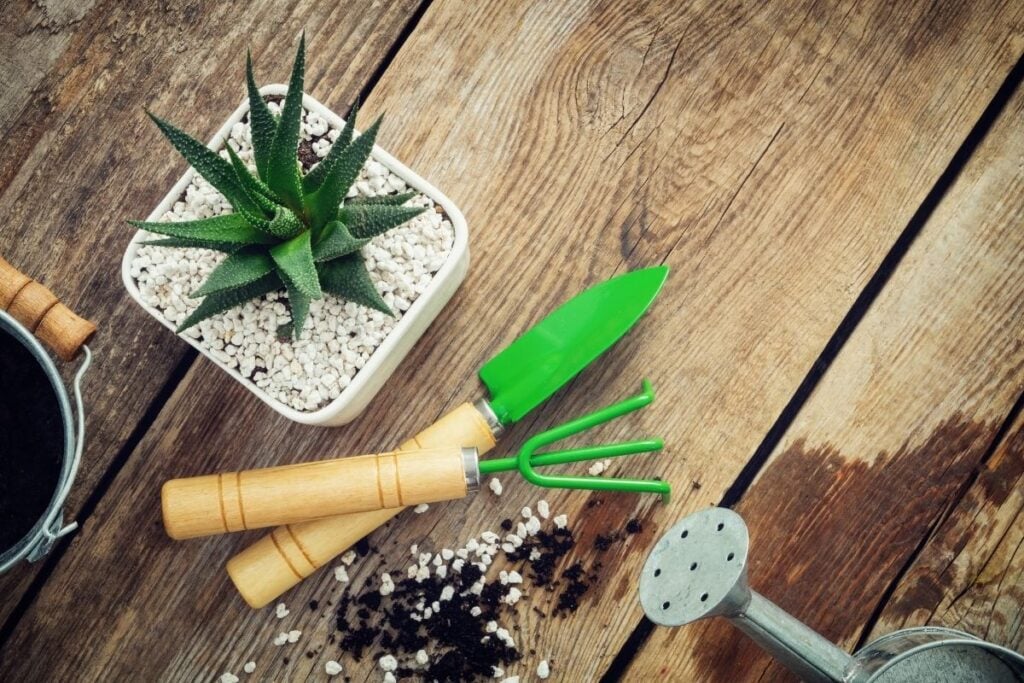
Haworthias can turn red due to overwatering or underwatering, the latter being the most accurate.
When you don’t water them, the plant stores water tightly in their leaves, which makes them red.
When you water them too much, first they will turn red and then brown, which is a clear sign of rotting.
Water the Haworthias once every 2 to 3 weeks during their growing months.
Also, check the moisture level before watering.
Water the Haworthia when the top few inches of the soil feel dry.
Don’t water them during the summers and winters.
Summer is their dormancy season, especially when temperatures rise above 80 degrees.
Here, they rest and don’t use any water.
Due to the plant’s slow growth, it will consume water very slowly.
Thus, the soil will take time to dry out.
Watering once a month in the winter is enough.
Poor soil
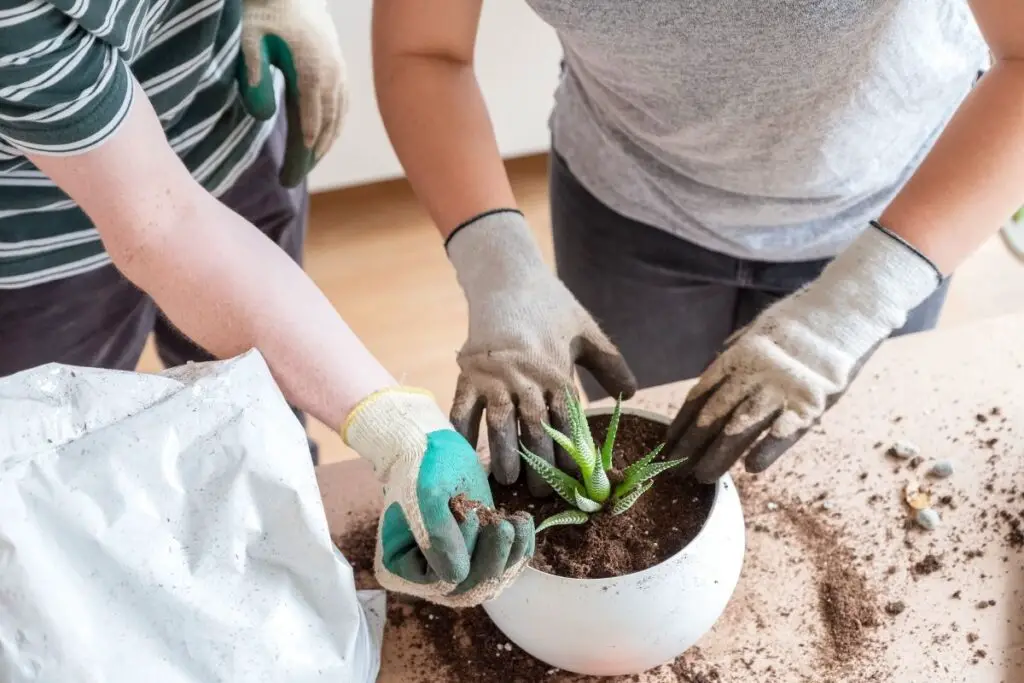
Good soil means nutritious soil with adequate drainage.
Good soil means a good home for all the plants.
If the soil doesn’t drain excess water properly, the roots of Haworthias will stay wet for a long time and start rotting.
They must experience a dry condition.
Haworthias don’t need highly nutritious soil, but they must be slightly nutritious, boosting their growth.
Some nutrients support healthy growth, and some maintain their rich color.
Looking for gardening supplies? We have tested 100's of products before recommending them to you guys. Check out our best pick below:
| Image | Gardening Supplies | Best Price? |
|---|---|---|
 Top
Top Top
Top | Raised Garden Bed Kit | Check On Amazon |
 | XLUX Soil Moisture Meter, Plant Water Monitor, Soil Hygrometer Sensor for Gardening, Farming, Indoor and Outdoor Plants, No Batteries Required | No Results |
 Top
Top Top
Top | 82 Pcs Garden Tools Set and Extra Succulent Tools Set | Check On Amazon |
 | Joeys Garden Expandable Garden Hose with 8 Function Hose Nozzle, Lightweight Anti-Kink Flexible Garden Hoses, Extra Strength Fabric with Double Latex Core, (50 FT, Black) | No Results |
 Top
Top Top
Top | Dual Chamber Compost Tumbler | Check On Amazon |
 Top
Top Top
Top | Sunnyglade Plant Stakes | Check On Amazon |
 Top
Top Top
Top | Organic Cold Pressed Neem Seed Oil | Check On Amazon |
 Top
Top Top
Top | Mighty Mint Gallon :-Insect and Pest Control Peppermint Oil | Check On Amazon |
 Top
Top Top
Top | Scotts DiseaseEx Lawn Fungicide | Check On Amazon |
 Top
Top Top
Top | Jacks Classic 20-20-20 All Purpose Fertilizer | Check On Amazon |
 Top
Top Top
Top | 30,000 Seeds Pollinator Attracting Wildflower Mixture | Check On Amazon |
 Top
Top Top
Top | Survival Vegetable Seeds Garden Kit-Over 16,000 Seeds | Check On Amazon |
Nutrient deficiency
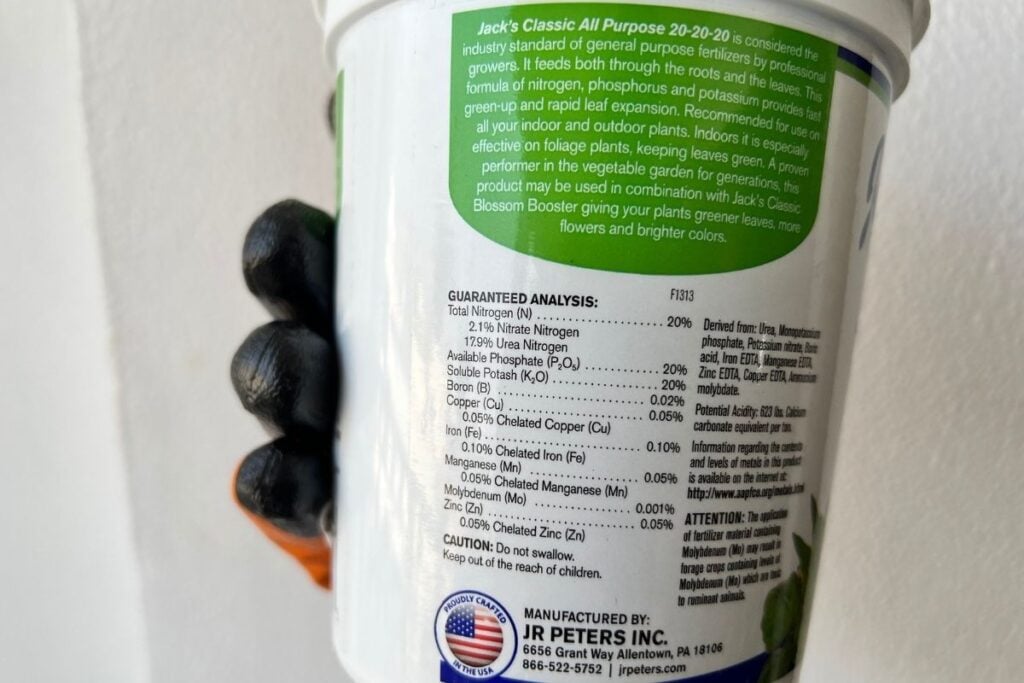
Haworthias are indeed low feeders, but they will need nutrients to stay and grow healthy.
They will change color when they run out of nutrients.
Without proper nutrients, the plant will go under stress, and they will not stay healthy and vibrant and start turning red.
Fertilization is needed at least once a month, every spring and fall.
It will keep them strong and help maintain their bright, vibrant colors.
It would be better to use organic fertilizers instead of chemical ones.
It will be better if you use a soil mix combined with fertilizers.
It works best for potted Haworthias.
You don’t need to fertilize them.
It will cause no harm if you forget to fertilize and don’t have time to feed them.
Fertilizer mixed with soil will do its work efficiently.
Fungal diseases
Fungal infections are very dangerous and even a nightmare, like a root rot.
Rust, botrytis blight, southern blight, etc., are some diseases that show red or brown spots on the leaves, flowers, and stems with yellow or orange haloes.
You can only save your plant from such diseases if you catch early signs.
To prevent these diseases from progressing, closely check the plant every 10 to 15 days.
Check both sides of the leaves, the stems, and the plant’s base.
The plant becomes susceptible to such diseases due to pests.
So first, treat the pests to stop the diseases.
Use neem oil, rubbing alcohol, and insecticidal soaps to deter them.
You can also apply neem oil to treat diseases. Mix it with some water and soap to dilute it as its oil.
You can use homemade fungicide made of 1 cup of baking soda, 1-gallon water, and ½ tsp liquid soap.
You can also use copper-based fungicides. Keep the surroundings neat and clean.
Rotting of the plant
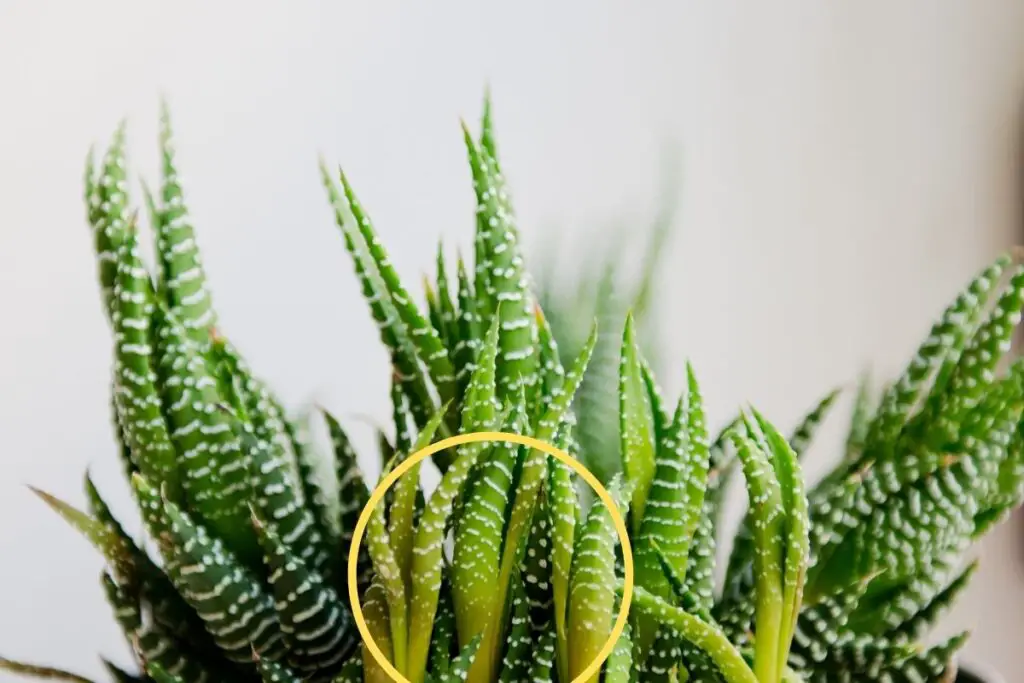
Besides root rot, poor drainage, and overwatering, it could happen due to high humidity or too much heat.
Outside there are fewer chances of high humidity.
But if the tall trees or plants are too close to Haworthias, it might increase humidity during hot conditions.
Though Haworthias benefit if tall trees or plants are around, they shouldn’t be too close.
Indoors, don’t keep Haworthias near bathroom, kitchen, fireplaces, or aquarium as these places are quite humid areas.
During the hot weather, these areas get more humid. So be careful.
Also read: Is Haworthia An Indoor Plant? (Indoor Care+Can We Keep It Outside)
How to take care of Haworthia to prevent them from turning red?
Haworthias are quite easy to grow once you get well acquainted with their basic care tips.
They will take very little of your time with low water, less sunlight, and rare fertilization.
Below, I have shared a brief care guide to prevent the Haworthias from turning red and staying healthy all year round.
Let them have suitable light.
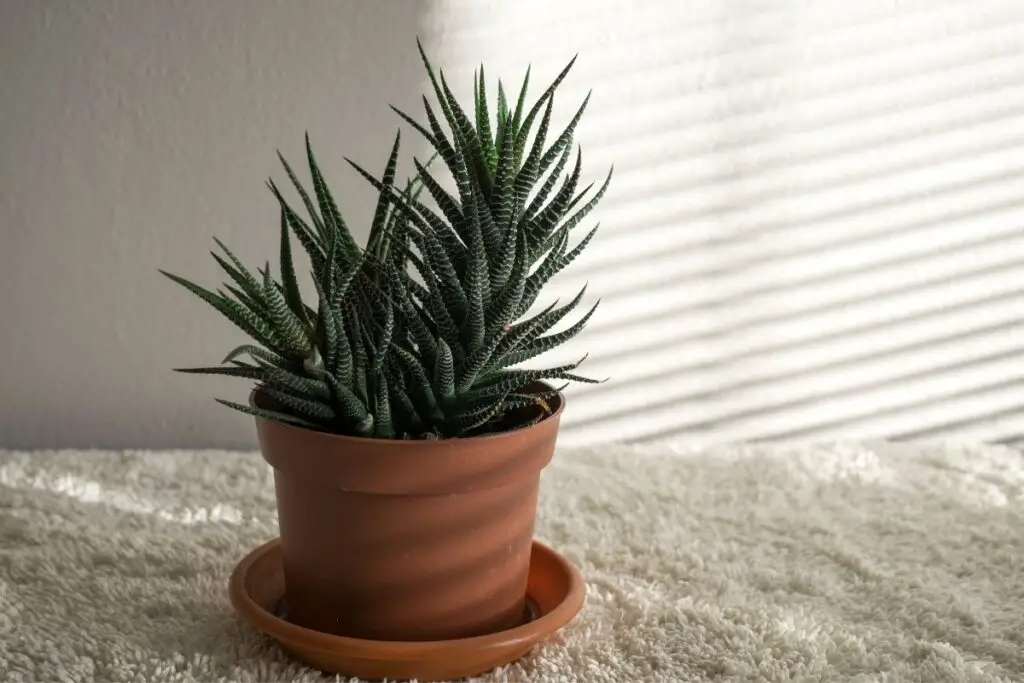
Haworthias grow best when they receive bright indirect sunlight.
Direct sunlight can make them turn red unless it is the direct sun of the early morning.
Till 11 am, let them direct sun for 3 to 4 hours.
After that, fix on shading clothes or nets to filter the light.
For indoor settings, put them near an east-facing window.
This direction gives bright direct sunlight in the morning.
As the day progresses, the sunlight will fade from this direction.
Put on sheer curtains if your plant is near a south or west-facing window.
Also read: How Much Light Does Haworthia Need? (Haworthia Light Requirements)
Maintain an ideal watering schedule
Water the Haworthias once every 2 to 3 weeks during their growing seasons, spring and fall.
This time gapping will give the plant enough time to dry out.
The plant will neither suffer overwatering nor underwatering.
You can also try the dry and soak method.
Water the plant thoroughly and water again when the soil fully dries out.
Another method is to wait for the next watering until the top 1-2 inches of the soil feels dry.
Don’t keep the plant thirsty for too long; don’t water when the soil is yet to get dry.
Also read: How Often To Water Haworthia? (Haworthia Water Requirements)
Plant them in a fast-draining soil
The soil bed for Haworthias must include some ingredients which can help in good drainage.
Aquarium gravel, horticulture pumice, perlite, or poultry grit can encourage proper drainage.
For potted Haworthias, use any of the following mixes:
Recipe 1
Recipe 2
Equal parts of:
- 60% Coarse sand
- 40% Potting soil.
Recipe 3
- 50% gravel of appropriate size
- 50% of soil, coarse sand, and organic fertilizer
Recipe 4
- 80% pumice
- 20% coir, 1-3 mm approx.
Recipe 5
- 40% parts potting soil
- 40% parts small gravel
- 20% part perlite or pumice
A soilless medium can improve drainage more than those mixed with soil.
For container plants, use a planter with drainage holes.
Also read: What Soil To Use For Haworthia? (+Ideal Soil Mix)
Fertilize once during the growing seasons
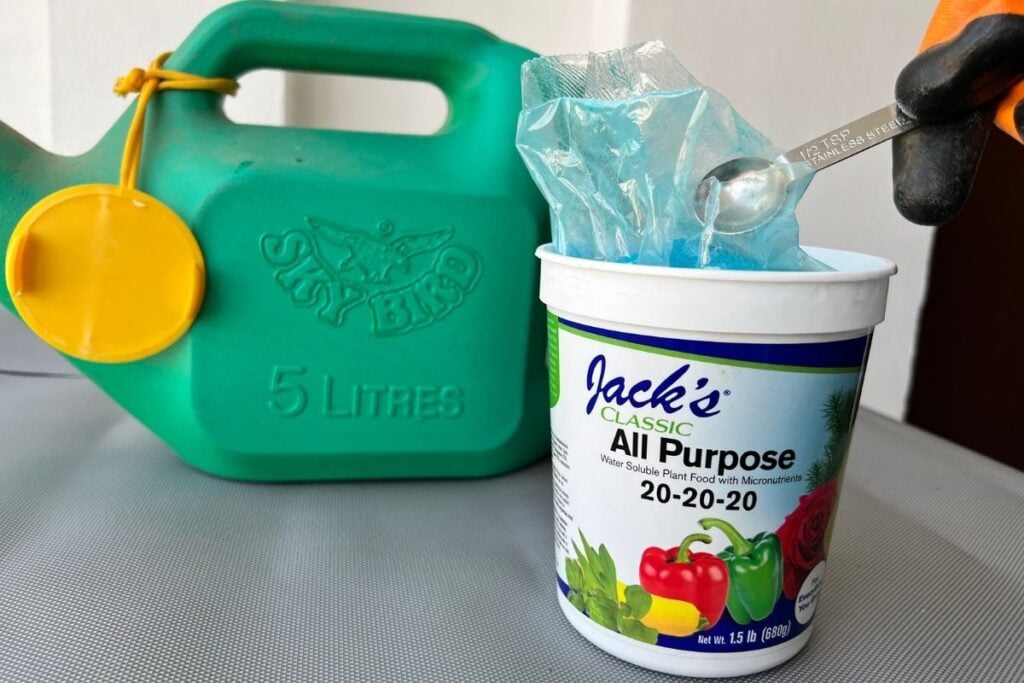
Fertilizing a little can prevent the Haworthias from experiencing nutrient deficiency which further will prevent redness.
The soil alone cannot fulfill all the nutrient requirements.
That is why fertilization is necessary.
It can give the plant those nutrients which might be missing in their soil.
Fertilize only during the spring and fall once. Avoid doing it in the summers or winters.
Also read: How To Fertilize Haworthia? (Best Fertilizer+When To Use)
Don’t let them face sudden or extreme temperatures.
To prevent sudden temperature change, you must ensure that Haworthias don’t receive any sudden temperatures.
Indoor Haworthias experience this when you shift your Haworthia in an air-conditioned room or heaters or humid areas.
Don’t suddenly change the location of your plant indoors.
Outdoors, the plant suffers quite less from this issue because the temperature change is gradual, and the plant adjusts them like that.
Ensure that some plants and tall trees surround the Haworthias at a distance.
The sudden air currents might give them temperature fluctuations.
These surrounding trees can protect them.
Also read:
- Haworthia Temperature Tolerance: High And Low-Temperature Guide
- Are Haworthia Frost Tolerant? (Cold Tolerance+Winter Care)
Check the plant daily.
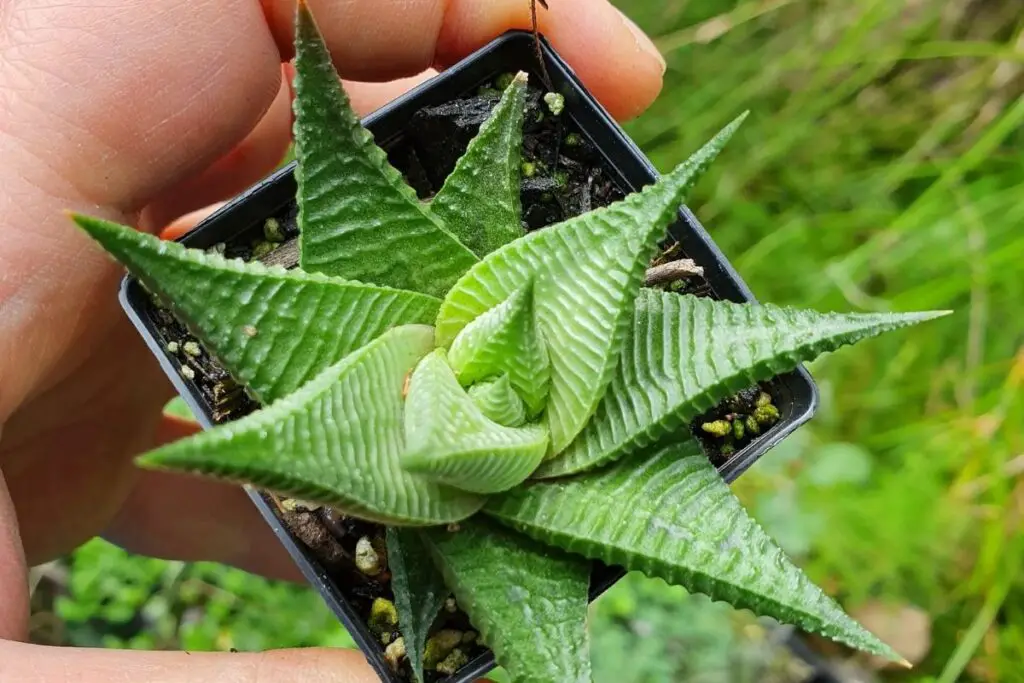
It will help you to identify the signs of pests and diseases quickly.
When the plant is already turning red, the problem is already present.
To prevent redness, observe the plant closely.
Mostly, look at both sides of the leaves and the stems.
If you don’t check them, the pests will make your plant susceptible to diseases.
Reviving the plant will be quite a challenging job once the disease occurs.
It is better to prevent it and stop it from happening.
Try not to overwater, underwater, or over-fertilize the plant.
These are some common reasons behind pests and fungus.
Final words
The common reasons behind Haworthia turning red are sun exposure and sudden temperatures. Don’t expose the Haworthia to the direct sun, or don’t change its location suddenly.
Water them when the soil gets dry, use well-drained soil, fertilize once in the growing seasons, and always check for pests and diseases.
There are not many reasons behind the problem, and you can easily solve these if you check for these few things. The plant will soon recover and come back healthy within a few weeks.
Reference: The Haworthia Society, Botanical Studies, University of Wisconsin-Madison, Sciencedirect, Researchgate, Haworthia Study.
